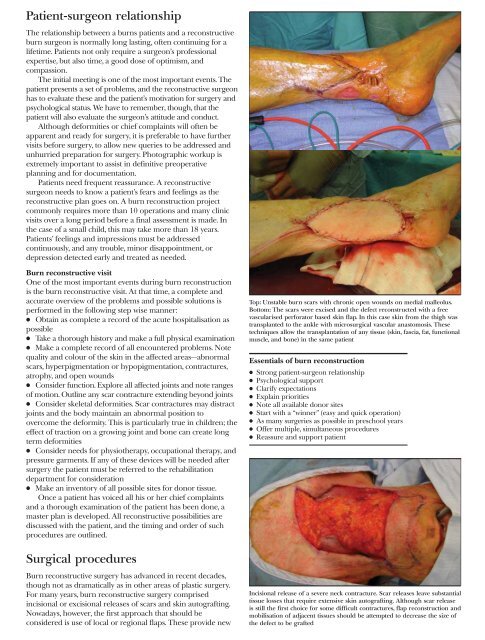ABC of Burns
Create successful ePaper yourself
Turn your PDF publications into a flip-book with our unique Google optimized e-Paper software.
Patient-surgeon relationship<br />
The relationship between a burns patients and a reconstructive<br />
burn surgeon is normally long lasting, <strong>of</strong>ten continuing for a<br />
lifetime. Patients not only require a surgeon’s pr<strong>of</strong>essional<br />
expertise, but also time, a good dose <strong>of</strong> optimism, and<br />
compassion.<br />
The initial meeting is one <strong>of</strong> the most important events. The<br />
patient presents a set <strong>of</strong> problems, and the reconstructive surgeon<br />
has to evaluate these and the patient’s motivation for surgery and<br />
psychological status. We have to remember, though, that the<br />
patient will also evaluate the surgeon’s attitude and conduct.<br />
Although deformities or chief complaints will <strong>of</strong>ten be<br />
apparent and ready for surgery, it is preferable to have further<br />
visits before surgery, to allow new queries to be addressed and<br />
unhurried preparation for surgery. Photographic workup is<br />
extremely important to assist in definitive preoperative<br />
planning and for documentation.<br />
Patients need frequent reassurance. A reconstructive<br />
surgeon needs to know a patient’s fears and feelings as the<br />
reconstructive plan goes on. A burn reconstruction project<br />
commonly requires more than 10 operations and many clinic<br />
visits over a long period before a final assessment is made. In<br />
the case <strong>of</strong> a small child, this may take more than 18 years.<br />
Patients’ feelings and impressions must be addressed<br />
continuously, and any trouble, minor disappointment, or<br />
depression detected early and treated as needed.<br />
Burn reconstructive visit<br />
One <strong>of</strong> the most important events during burn reconstruction<br />
is the burn reconstructive visit. At that time, a complete and<br />
accurate overview <strong>of</strong> the problems and possible solutions is<br />
performed in the following step wise manner:<br />
x Obtain as complete a record <strong>of</strong> the acute hospitalisation as<br />
possible<br />
x Take a thorough history and make a full physical examination<br />
x Make a complete record <strong>of</strong> all encountered problems. Note<br />
quality and colour <strong>of</strong> the skin in the affected areas—abnormal<br />
scars, hyperpigmentation or hypopigmentation, contractures,<br />
atrophy, and open wounds<br />
x Consider function. Explore all affected joints and note ranges<br />
<strong>of</strong> motion. Outline any scar contracture extending beyond joints<br />
x Consider skeletal deformities. Scar contractures may distract<br />
joints and the body maintain an abnormal position to<br />
overcome the deformity. This is particularly true in children; the<br />
effect <strong>of</strong> traction on a growing joint and bone can create long<br />
term deformities<br />
x Consider needs for physiotherapy, occupational therapy, and<br />
pressure garments. If any <strong>of</strong> these devices will be needed after<br />
surgery the patient must be referred to the rehabilitation<br />
department for consideration<br />
x Make an inventory <strong>of</strong> all possible sites for donor tissue.<br />
Once a patient has voiced all his or her chief complaints<br />
and a thorough examination <strong>of</strong> the patient has been done, a<br />
master plan is developed. All reconstructive possibilities are<br />
discussed with the patient, and the timing and order <strong>of</strong> such<br />
procedures are outlined.<br />
Top: Unstable burn scars with chronic open wounds on medial malleolus.<br />
Bottom: The scars were excised and the defect reconstructed with a free<br />
vascularised perforator based skin flap. In this case skin from the thigh was<br />
transplanted to the ankle with microsurgical vascular anastomosis. These<br />
techniques allow the transplantation <strong>of</strong> any tissue (skin, fascia, fat, functional<br />
muscle, and bone) in the same patient<br />
Essentials <strong>of</strong> burn reconstruction<br />
x Strong patient-surgeon relationship<br />
x Psychological support<br />
x Clarify expectations<br />
x Explain priorities<br />
x Note all available donor sites<br />
x Start with a “winner” (easy and quick operation)<br />
x As many surgeries as possible in preschool years<br />
x Offer multiple, simultaneous procedures<br />
x Reassure and support patient<br />
Surgical procedures<br />
Burn reconstructive surgery has advanced in recent decades,<br />
though not as dramatically as in other areas <strong>of</strong> plastic surgery.<br />
For many years, burn reconstructive surgery comprised<br />
incisional or excisional releases <strong>of</strong> scars and skin autografting.<br />
Nowadays, however, the first approach that should be<br />
considered is use <strong>of</strong> local or regional flaps. These provide new<br />
Incisional release <strong>of</strong> a severe neck contracture. Scar releases leave substantial<br />
tissue losses that require extensive skin autografting. Although scar release<br />
is still the first choice for some difficult contractures, flap reconstruction and<br />
mobilisation <strong>of</strong> adjacent tissues should be attempted to decrease the size <strong>of</strong><br />
the defect to be grafted



